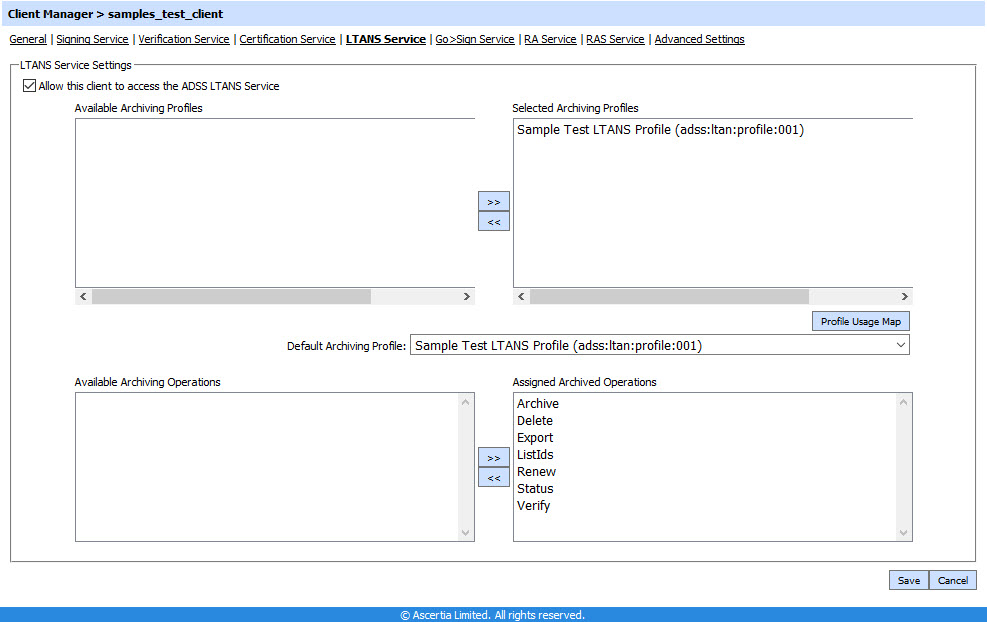LTANS Service
The following configurations relating to the LTANS service can be made within Client Manager:
- Allow the client to access ADSS LTANS service.
- Assign the LTANS Profiles which can be accessed by this client.
- Configure a default LTANS Profile for this client.
- Configure the archive operations which can be accessed by this client.
Once a client is registered, permissions to access the LTANS Service can be granted by editing this client. On the edit screen, clicking on the LTANS Service link at the top of the page shows the following screen:

Select the Allow this client to access the ADSS LTANS Service checkbox. This ensures that the client can make LTANS Service requests to ADSS Server. If the application also needs to access other ADSS services (e.g. verifying signed documents or generating and certifying user signing keys) then the relevant links (Verification Service, Certification Service etc.) should be followed to allow permissions for these services.
The next action is to define which LTANS profiles (configured within the ADSS LTANS Service) are to be made available to this client. Remember that LTANS profiles are server configurations that define the details of how an archive is to be created by the ADSS Server. By default all the existing LTANS profiles will be made available to each newly registered client. Different clients may need to have access to different LTANS profiles. In order to allow access to a particular LTANS profile, simply move that profile from the left-hand group box labelled Available LTANS Profiles to the right-hand group box labelled Selected LTANS Profiles using the >> button shown in the screenshot above. Clients can only reference those LTANS profiles that are shown in the Selected LTANS Profiles. To remove access to a particular profile use the opposite << button to move the relevant profile back to the right-hand box.
The Profile Usage Map button provides an overview of which profiles are being used by which clients.
The Default LTANS Profile defines which profile to use in case the request message from this client does not reference any specific LTANS profile.
The lower half of the screen, allows you to define which LTANS operations the client can access. By default the client application will be able to access all seven operations i.e.
- ARCHIVE (for sending objects for archival) .
- DELETE (for deleting archive objects from the LTANS Service which were previously archived).
- EXPORT (for exporting out previously archived objects from the LTANS Service).
- LISTID (for getting the list of the Reference ID's which are created by the client).
- RENEW (for renewing the archive evidence).
- STATUS (for getting the status of the specified archive object).
- VERIFY (for verifying the integrity and validity of the specified archived data).
Again simply move any archive operation(s) that are not to be allowed for this client to the left-hand list box.
Click the Save button when the list is updated to store the changes.
|
|
Whenever configurations are updated on this page remember to restart the LTANS Service and have the changes take effect. |
See also
Verification Service
Certification Service
XKMS Service
LTANS Service
Decryption Service
Go-Sign Service
RA Service
RAS Service
SAM Service
CSP Service

